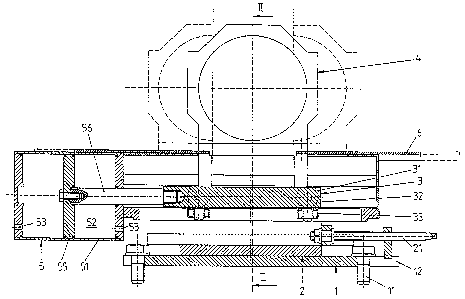Some of the information on this Web page has been provided by external sources. The Government of Canada is not responsible for the accuracy, reliability or currency of the information supplied by external sources. Users wishing to rely upon this information should consult directly with the source of the information. Content provided by external sources is not subject to official languages, privacy and accessibility requirements.
Any discrepancies in the text and image of the Claims and Abstract are due to differing posting times. Text of the Claims and Abstract are posted:
| (12) Patent: | (11) CA 2168538 |
|---|---|
| (54) English Title: | APPARATUS FOR ADJUSTING ONE OF THE BEARING BLOCKS OF A ROLLER |
| (54) French Title: | DISPOSITIF PERMETTANT DE REGLER UN DES PALIERS D'UN ROULEAU |
| Status: | Term Expired - Post Grant Beyond Limit |
| (51) International Patent Classification (IPC): |
|
|---|---|
| (72) Inventors : |
|
| (73) Owners : |
|
| (71) Applicants : |
|
| (74) Agent: | SMART & BIGGAR LP |
| (74) Associate agent: | |
| (45) Issued: | 2004-02-17 |
| (22) Filed Date: | 1996-01-31 |
| (41) Open to Public Inspection: | 1996-09-24 |
| Examination requested: | 1999-12-20 |
| Availability of licence: | N/A |
| Dedicated to the Public: | N/A |
| (25) Language of filing: | English |
| Patent Cooperation Treaty (PCT): | No |
|---|
| (30) Application Priority Data: | ||||||
|---|---|---|---|---|---|---|
|
Apparatus for adjusting one of the bearing blocks (4) of a roller in a group of rollers, to support and move an endlessly moved belt, such as a screen strip, conveyor belt or the like, in a paper-making system, wherein the bearing block (4) is disposed on a final control element (3) which is adjustable in the direction of motion of the belt by means of an adjusting device (5) relative to a support frame (1), as a result of which the angular position of the roller supported in the bearing block (4) can be varied relative to the longitudinal direction of the belt. Therein, the final control elements is embodied by a car (3) which is provided with wheels (32) or the like and which can be moved about by the adjusting device (50 relative to the support frame (1) (Fig. 2).
Dispositif de réglage de l'un des supports de palier (4) d'un rouleau d'un ensemble de rouleaux destinés à soutenir et à déplacer une bande sans fin en mouvement, telle que la bande filtrante, la bande de transport ou similaire d'une installation de production de papier, le support de palier (4) étant disposé sur un élément de commande final (3) qui est réglable dans le sens de déplacement de la bande au moyen d'un deuxième dispositif de réglage (5), par rapport au bâti porteur (1), ce qui fait que la position angulaire du rouleau monté dans le support de palier (4) est variable par rapport à la direction longitudinale de la bande. Les éléments de commande finaux sont des chariots (3) pourvus de roulettes (32) ou similaires et pouvant être déplacés par un dispositif de réglage (50) par rapport au bâti porteur (1) (FIG 2).
Note: Claims are shown in the official language in which they were submitted.
Note: Descriptions are shown in the official language in which they were submitted.

2024-08-01:As part of the Next Generation Patents (NGP) transition, the Canadian Patents Database (CPD) now contains a more detailed Event History, which replicates the Event Log of our new back-office solution.
Please note that "Inactive:" events refers to events no longer in use in our new back-office solution.
For a clearer understanding of the status of the application/patent presented on this page, the site Disclaimer , as well as the definitions for Patent , Event History , Maintenance Fee and Payment History should be consulted.
| Description | Date |
|---|---|
| Inactive: Expired (new Act pat) | 2016-01-31 |
| Inactive: Office letter | 2007-05-11 |
| Inactive: Entity size changed | 2007-03-26 |
| Inactive: Corrective payment - s.78.6 Act | 2007-02-01 |
| Inactive: IPC from MCD | 2006-03-12 |
| Inactive: IPC from MCD | 2006-03-12 |
| Grant by Issuance | 2004-02-17 |
| Inactive: Cover page published | 2004-02-16 |
| Pre-grant | 2003-12-05 |
| Inactive: Final fee received | 2003-12-05 |
| Notice of Allowance is Issued | 2003-10-14 |
| Notice of Allowance is Issued | 2003-10-14 |
| Letter Sent | 2003-10-14 |
| Inactive: Approved for allowance (AFA) | 2003-10-02 |
| Amendment Received - Voluntary Amendment | 2003-06-10 |
| Inactive: S.30(2) Rules - Examiner requisition | 2003-01-16 |
| Amendment Received - Voluntary Amendment | 2000-02-09 |
| Inactive: Application prosecuted on TS as of Log entry date | 2000-01-14 |
| Letter Sent | 2000-01-14 |
| Inactive: Status info is complete as of Log entry date | 2000-01-14 |
| All Requirements for Examination Determined Compliant | 1999-12-20 |
| Request for Examination Requirements Determined Compliant | 1999-12-20 |
| Application Published (Open to Public Inspection) | 1996-09-24 |
There is no abandonment history.
The last payment was received on 2003-11-17
Note : If the full payment has not been received on or before the date indicated, a further fee may be required which may be one of the following
Please refer to the CIPO Patent Fees web page to see all current fee amounts.
Note: Records showing the ownership history in alphabetical order.
| Current Owners on Record |
|---|
| KLAUS BARTELMUSS |
| HEINZ BARTELMUSS |
| Past Owners on Record |
|---|
| None |